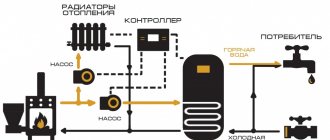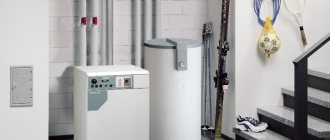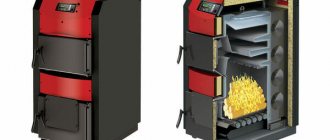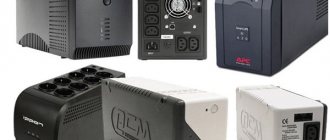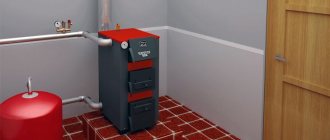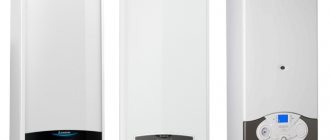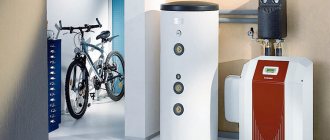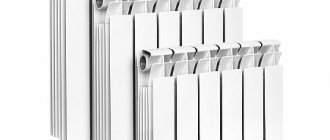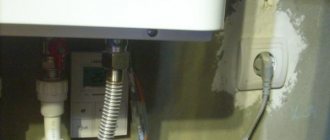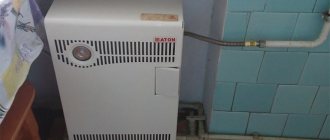During the cold season, a serious problem arises when ventilating rooms due to the significant temperature difference between the air inside and coming from outside. The cold stream rushing down creates an unfavorable microclimate in production, offices, residential apartments and houses, and also creates an unacceptable vertical temperature gradient in warehouses.
A common solution is to include in the supply ventilation a device for heating the incoming flow, the operation of which requires significant energy consumption. However, when using the technology of transferring heat to incoming air from outgoing air using a special device called a recuperator, energy consumption can be significantly reduced. In the summer, when the outside temperature is significantly higher than the room temperature, it effectively cools the incoming flow.
General information and operating principle
A recuperator is a device for ventilating a room, using the heat of the exhaust air for continuous heat exchange through the dividing surface with the incoming flow.
The technology ensures the preservation and return of “internal” heat, which is intended to be blown outside simultaneously with the hood. In the process of constant circulation, flows move in two directions. Warm exhaust air is removed from the room through a heat exchanger, and the incoming cold air is heated and disinfected due to heat exchange. At the same time, the temperature regime can be adjusted with the possibility of maintaining not only heat, but also coolness.
Main stages:
- air collection;
- feeding it into the system using a fan;
- passing through a recuperator;
- exhaust and removal outside the ventilated room;
- supply of outside air passing through a recuperator;
- partial heat transfer from the exhaust to the incoming flow.
Device
The design of a ventilation unit with recovery is quite simple and includes:
- body made of sheet steel, aluminum profile and sandwich panels. Equipped with sound insulation, thermal insulation and vibration protection;
- air ducts with valves and dampers for flow distribution;
- output and input grilles;
- fan for exhaust and supply;
- filter system to prevent the entry of foreign objects, dirt and dust;
- recovery unit;
- electronic control unit;
- additional systems for humidification, ionization, CO2 sensors, cold plasma generator.
Basic elements of ventilation systems
Recuperator in the ventilation system
Ventilation with heat recovery in a private house consists not only of a heat exchanger unit.
The system includes:
- protective grilles;
- air ducts;
- valves;
- fans;
- filters.
- automation and control bodies.
The grilles protect against accidental entry of large objects, birds and rodents into the system, which can cause accidents. This option is possible when a foreign object hits the fan impeller. The consequences may be:
- deformed blades and increased levels of vibration (noise);
- jamming of the fan rotor and combustion of the electric motor windings;
- unpleasant odor from dead and decaying animals.
The total cross-section of the grille openings should not be significantly smaller than the cross-section of the air ducts; this leads to a decrease in the performance of the entire system.
Air ducts and fittings (turns, tees, adapters) are purchased at the same time; we try to purchase products from the same manufacturer. The difference in size leads to gaps in joints, disruption of flow and turbulence.
In severe frost, you can close the inlet valve temporarily
Corrugated air ducts, which create resistance to air flow and increased noise during operation, are not used for ventilation with a recuperator.
Air valves are needed to temporarily change the parameters of air movement, for example, they can be used to close the inlet channel during a particularly frosty period of time, when the recuperator cannot cope with heating the air to the required temperature.
Filters are installed in all models of ventilation with recovery. They protect equipment from street dust and tree fluff, which quickly clog heat exchangers.
Fans can be built into the heat exchanger block or installed in ducts. When making calculations, be sure to determine the required power of the device.
You cannot save money on buying fans - cheap, low-quality products are not designed for long-term operation. As fans wear out, they produce noise and lead to vibrations of the ventilation components, which causes discomfort when in the premises.
Advantages of equipment with recovery
- High efficiency associated with a significant reduction in costs for ventilation, air conditioning and heating of the facility.
- High-quality heating of the incoming flow in cold weather.
- Affordable price, which is not much more than classic ventilation equipment.
- Transferring moisture to the supply flow to maintain a comfortable humidity level.
- Convenient control that can be performed remotely using mobile devices or a computer.
- High degree of electrical protection with automatic shutdown in case of voltage surges, operation blockages, device overheating and phase loss.
- Low noise level thanks to special devices made from materials that are resistant to vibration and suppress the noise of operating fans.
- Long service life.
Features of various types of recuperators
There are several structurally different options for implementing heat exchange between cold and heated air flows. Each of them has its own distinctive features, which determine the main purpose for each type of recuperator.
Plate cross-flow recuperator
The design of the plate recuperator is based on thin-walled panels, connected alternately in such a way as to alternate the passage of flows of different temperatures between them at an angle of 90 degrees. One of the modifications of this model is a device with finned channels for air passage. It has a higher heat transfer coefficient.
Alternate passage of warm and cold air flow through the plates is realized by bending the edges of the plates and sealing the joints with polyester resin
Heat exchange panels can be made of various materials:
- copper, brass and aluminum-based alloys have good thermal conductivity and are not susceptible to rust;
- plastic made from a hydrophobic polymer material with a high thermal conductivity coefficient and low weight;
- hygroscopic cellulose allows condensation to penetrate through the plate and back into the room.
The disadvantage is the possibility of condensation forming at low temperatures. Due to the small distance between the plates, moisture or ice significantly increases aerodynamic drag. In case of freezing, it is necessary to block the incoming air flow to warm the plates.
The advantages of plate recuperators are as follows:
- low cost;
- long service life;
- long period between preventive maintenance and ease of its implementation;
- small dimensions and weight.
This type of recuperator is most common for residential and office premises. It is also used in some technological processes, for example, to optimize fuel combustion during the operation of furnaces.
Drum or rotary type
The operating principle of a rotary recuperator is based on the rotation of a heat exchanger, inside of which there are layers of corrugated metal with high heat capacity. As a result of interaction with the outgoing flow, the drum sector is heated, which subsequently gives off heat to the incoming air.
The fine-mesh heat exchanger of a rotary recuperator is susceptible to clogging, so you need to pay special attention to the quality operation of fine filters
The advantages of rotary recuperators are as follows:
- quite high efficiency compared to competing types;
- return of a large amount of moisture, which remains in the form of condensation on the drum and evaporates upon contact with incoming dry air.
This type of recuperator is less often used for residential buildings for apartment or cottage ventilation. It is often used in large boiler houses to return heat to furnaces or for large industrial or commercial premises.
However, this type of device has significant disadvantages:
- a relatively complex design with moving parts, including an electric motor, drum and belt drive, which requires constant maintenance;
- increased noise level.
Sometimes for devices of this type you can come across the term “regenerative heat exchanger”, which is more correct than “recuperator”. The fact is that a small part of the exhaust air gets back due to the loose fit of the drum to the body of the structure.
This imposes additional restrictions on the ability to use devices of this type. For example, polluted air from heating stoves cannot be used as a coolant.
Tube and casing system
A tubular type recuperator consists of a system of thin-walled tubes of small diameter located in an insulated casing, through which there is an influx of outside air. The casing removes warm air from the room, which heats the incoming flow.
Warm air must be discharged through the casing, and not through a system of tubes, since it is impossible to remove condensate from them
The main advantages of tubular recuperators are as follows:
- high efficiency due to the countercurrent principle of movement of the coolant and incoming air;
- simplicity of design and absence of moving parts ensures low noise levels and rarely requires maintenance;
- long service life;
- the smallest cross-section among all types of recovery devices.
Tubes for this type of device use either light-alloy metal or, less commonly, polymer. These materials are not hygroscopic, therefore, with a significant difference in flow temperatures, intense condensation may form in the casing, which requires a constructive solution for its removal. Another disadvantage is that the metal filling has significant weight, despite its small dimensions.
The simplicity of the design of a tubular recuperator makes this type of device popular for self-production. Plastic pipes for air ducts, insulated with a polyurethane foam shell, are usually used as an external casing.
Device with intermediate coolant
Sometimes the supply and exhaust air ducts are located at some distance from each other. This situation may arise due to the technological features of the building or sanitary requirements for reliable separation of air flows.
In this case, an intermediate coolant is used, circulating between the air ducts through an insulated pipeline. Water or a water-glycol solution is used as a medium for transferring thermal energy, the circulation of which is ensured by the operation of a heat pump.
A recuperator with an intermediate coolant is a voluminous and expensive device, the use of which is economically justified for premises with large areas
If it is possible to use another type of recuperator, then it is better not to use a system with an intermediate coolant, since it has the following significant disadvantages:
- low efficiency compared to other types of devices, therefore such devices are not used for small rooms with low air flow;
- significant volume and weight of the entire system;
- the need for an additional electric pump to circulate the liquid;
- increased noise from the pump.
There is a modification of this system when, instead of forced circulation of the heat exchange fluid, a medium with a low boiling point, such as freon, is used. In this case, movement along the contour is possible naturally, but only if the supply air duct is located above the exhaust air duct.
Such a system does not require additional energy costs, but only works for heating when there is a significant temperature difference. In addition, it is necessary to fine-tune the point of change in the state of aggregation of the heat exchange fluid, which can be realized by creating the required pressure or a certain chemical composition.
Criterias of choice
In order to avoid mistakes when choosing, you should pay attention to the recommendations and advice of experts, including:
- Availability of an additional heating source to protect against freezing and maintain efficiency in the cold season. As a rule, equipment operates stably down to -10⁰С, but in severe frosts failures are possible.
- The thickness of the body and the material of the frame with the presence of cold bridges, which must withstand drops in outside temperature without additional insulation.
- Weight and dimensions must correspond to the installation room.
- Taking into account the free pressure of the fan corresponding to the volume of the ventilated room.
- Equipment with automation systems and the ability to connect additional options, which, while increasing comfort during operation of the equipment, reduce costs.
- The main calculated performance parameter is the volume of air entering the room in one hour. According to sanitary standards, the value should correspond to one times the total volume of the premises served (kitchen, bedroom, living room) or 60 sq. for an adult.
- The fan pressure must ensure pumping of the entire ventilation system of the house.
- The noise level cannot interfere with the comfort of staying in the room and depends on the material of manufacture and the thickness of the housing, fan power and other parameters.
Thus, when choosing a supply and exhaust system with recovery, you should consider it as a climate complex for maintaining air flow, temperature and humidity in a given mode. At the same time, equipping with additional heaters, coolers, humidifiers and other dehumidifiers becomes an objective necessity. All this should minimize human participation in the control process and improve the quality of the indoor microclimate.
Heat loss: when money goes down the drain
It should be noted that the design of ventilation of this type should provide for heating the supplied street air. This function is in demand during the cold season: if the incoming air flow is not heated, it will lead to cooling of the room.
In this case, ventilation will become a powerful “air conditioner”, supplying cold when it is not needed at all. Even if the heating in the room is working at full capacity, the constant flow of cold air will make living in it impossible. The heat will “fly” outside, the temperature will drop by 8-12 degrees, and there will be drafts in the room. The conclusion is simple - supply and exhaust ventilation systems must be equipped with an air heating system (heater).
Heating air using such systems requires significant energy consumption. Thus, the supply and exhaust ventilation heating unit consumes 1 kW of electricity per hour to heat 55 m³ of air, from street temperatures -30 °C to room temperature.
It is worth remembering here that the duration of the period of negative air temperatures in most regions of Russia can be up to 6 months. At this time, the cost of heating air by ventilation may exceed the cost of heating.
Meanwhile, ventilation units with an energy-efficient air heating system are very popular in Russia.
. This was made possible through the use of heat recovery technology.
Where can I buy
Popular models of various types can be found in branded departments of stores offering ventilation equipment. You can check and view the device, and the sellers will give valuable recommendations and advice: how the product differs from each other, which company is better to buy, how to choose and how much it costs.
If there is no normal choice at your place of residence, a suitable unit can be ordered online from the online store of the manufacturer or dealer of ventilation equipment. There are various models with photos, technical characteristics, as well as customer reviews.
Offers of air handling units in Moscow:
- with a plate recuperator priced from 1,790 rubles (MMotors 4) to 4,424,800 rubles (Breezart 16000 Pool Pro);
- membrane type - from RUB 131,566. (Blauberg FRESHBOX 100 ERV) up to 242,000 (Blauberg KOMFORT EC SB 350-E S21);
- rotary type - from 132,000 rubles (GlobalVent Climate-R300) to 2,744,300 rubles. (Shuft UniMAX-R 6800SE EC).
